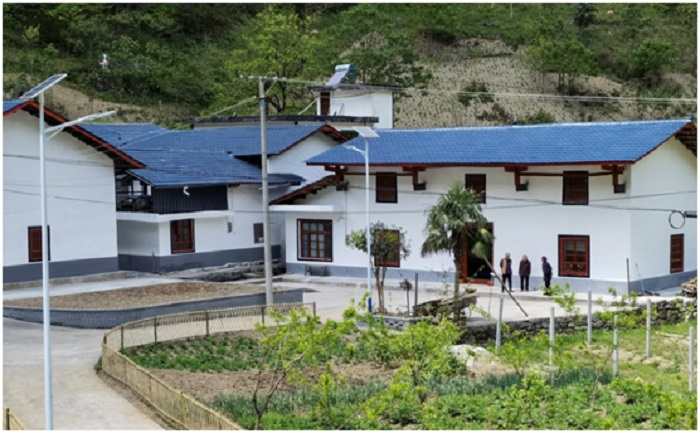



Twenty-two households in Dahe village, northwest China’s Shaanxi province recently renovated and upgraded their mud houses under a local government-funded program, which has brought a new look to the village.
The 22 houses now look beautiful and clean with white outer walls and blue tiles on the top. Besides, they are all equipped with flush toilets, hardened flooring and ceramic countertops.
“We just love living in a house like this,” said Tan Xianhua, a 67-year-old villager of Dahe village, which sits in Shimen township, Langao county. He said his house was almost as functional and comfortable as urban apartments after renovation, and he was having a great time living in it.
Responding to its residents’ aspiration, the government of the Langao county has funded the renovation and upgrading over 10,000 mud houses of 3,067 households since this year.
Langao is a mountainous county where most of the residential buildings were constructed with mud in the last century. Among the 170,000 residents in the county, 150,000 were living in mud houses as of 2000.
“Most of the mud houses were built long ago. The walls had been mottled and blackened with soot. There were pits on the floors and leaks on the ceiling. These houses were uninhabitable and had safety hazards,” said Liu Wenming, director of the housing and urban-rural development bureau of Langao county.
Earlier this year, Langao county invested 100 million yuan ($14.84 million) to subsidize residents upgrading the rooftops, windows and doors, floorings, walls and outer walls, kitchens, bathrooms, animal pens and circuits of mud houses, aiming to improve the quality and functions of the houses, as well as the overall environment.
While the mud house renovation program was advancing, some abandoned buildings needed to be demolished, which might hurt the interests of part of the villagers. Therefore, Langao county requested its primary-level cadres to carry out the renovation work in a flexible manner.
“People’s affairs shall be discussed by the people, not purely decided by the cadres. What remains after the demolishing shall fit into the surrounding environment and meet people’s demands,” said Lu Xiuhuai, an official directing the renovation program in Shimen township dispatched by Langao county’s housing and urban-rural development bureau.
Langao county, when implementing the mud house renovation program, has always adhered to a bottom-up approach and solicited opinions from the villagers. In a steadfast and orderly manner, it advanced the program according to local conditions and demolished 220 abandoned and illegal buildings. Not a single dispute emerged.
For Pang Qimei, a 39-year-old villager from Chaoyang village, Zuolong township, the benefits of the renovation program are multifaceted. The solid new rooftop has put an end to leakage, and the floors, which were pitted in the old days, have become hardened and flattened. Besides, there is a shower room to take a convenient bath, and the countertop and the whole kitchen are now covered with clean white ceramic tiles.
Pang and her husband made some money these years, so they were planning to buy an apartment in the city once they had enough savings. Therefore, they did not intend to renovate their house at the beginning.
“But we didn’t have enough money to buy an apartment in the city. Even if we did, we would still face heavy economic burdens. Thanks to the renovation program, we upgraded our house, so we are no longer in a rush to buy an apartment in the city,” Pang told People’s Daily.
This spring, the woman started cultivation and planted two mu (0.13 hectares) of crops. She said she would go back to her familiar ground – poultry farming, when her husband returns.
“Conforming to the aspiration of the people, the renovation program aims to bring a better life to the people and lead them to common prosperity,” said Ma Hongwei, Party head of Langao county.


Cooperation between China and Nigeria had.



Nigerian government has urged trainees of.



Minister of State for Foreign Affairs,.


The Nigerian Government has congratulated the.


The Humanitarian Service Diamond Awards has.
A Chinese Company, Inner Galaxy Steel.


The Programme Coordinator, Regulatory, Compliance and.


A Non-Governmental Organization (NGO), Committee for.
The Trustfund Pensions Limited has chided.


The House of Representatives Committee on.
Leave a Comment